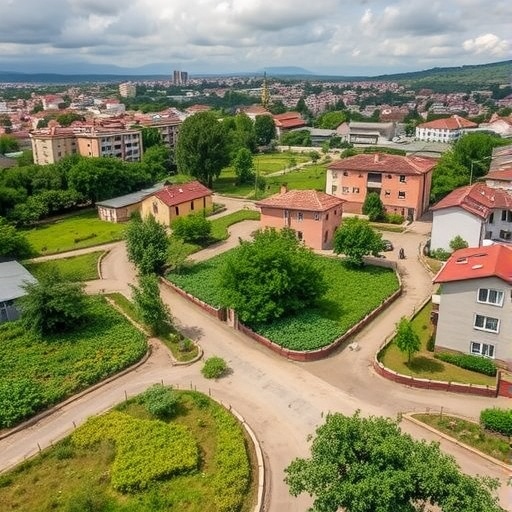In the rapidly urbanizing world, the importance of incorporating green infrastructure into city landscapes cannot be overstated. An enlightening study has recently emerged from Ethiopia, focusing on the critical role of woody plant species in urban green infrastructure. This research has profound implications for the future of urban environments, highlighting the ways in which they can contribute to ecosystem services, particularly in terms of conservation and carbon sequestration.
Urban areas, while often seen as concrete jungles, possess immense potential for sustainability through the integration of green infrastructure. The presence of green spaces, including parks, gardens, and green roofs, can dramatically alter the urban landscape, providing not just aesthetic benefits but also crucial ecological functions. In Ethiopia, the study by Negash and Simegn delves into how urban green infrastructure can facilitate biodiversity conservation and, more specifically, the conservation of woody plant species. These plants are not merely decoration; they are essential components of urban ecosystems that contribute to the overall health of the environment.
One of the most important services provided by urban green infrastructure is carbon sequestration. As cities expand and greenhouse gas emissions continue to rise, the need for effective carbon sinks becomes more pressing. Woody plants, which include trees and shrubs, are particularly effective at absorbing carbon dioxide from the atmosphere. Through the process of photosynthesis, they not only sequester carbon but also contribute to the reduction of urban heat islands, making cities more livable.
The study reveals significant insights into the specific woody species that thrive in urban areas within Ethiopia, emphasizing their adaptability and resilience. Each species plays a unique role in the ecosystem, supporting various forms of wildlife and increasing the overall biodiversity of urban settings. This biodiversity is crucial for maintaining ecological balance, enhancing urban resilience against climate change, and ensuring sustainable development.
Furthermore, the research highlights the socio-economic benefits that arise from the conservation of these woody species. Community engagement in the maintenance and enhancement of urban green spaces fosters a sense of ownership and responsibility among residents. This connection to nature can improve mental health and overall well-being, creating happier and more productive communities. By fostering these green spaces, cities can also create job opportunities in landscaping, horticulture, and environmental stewardship.
While the benefits of urban green infrastructure are evidently significant, the study underscores the challenges faced in its implementation. Urban planning often overlooks the ecological value of green spaces, prioritizing development over conservation. This can lead to the degradation of natural habitats and a decline in ecosystem services. However, the authors propose that integrating green infrastructure into urban planning is not only feasible but essential for sustainable urban development.
Understanding the ecological dynamics involved in planting and nurturing woody species is fundamental for their success. The study outlines key considerations such as species selection, the importance of native plants, and understanding local climatic conditions. These factors are vital for ensuring that urban green spaces remain sustainable and contribute effectively to carbon sequestration efforts. With strategic planning and community involvement, cities can maximize their green potential.
Negash and Simegn’s analysis extends beyond just the local level; it speaks to global challenges regarding climate change and urbanization. As cities around the world grapple with the effects of climate change, the insights provided in this study offer a roadmap for integrating natural solutions into urban environments. The importance of community-driven approaches cannot be overstated, as they are critical to the longevity and effectiveness of urban green initiatives.
Moreover, the preservation of woody plant species contributes to the fight against climate change in a very tangible way. By sequestering carbon, these plants help mitigate the greenhouse gas emissions associated with urban activities. The more green infrastructure is integrated into city planning, the greater the potential for cities to become carbon neutral. This is a vital consideration as countries strive to meet international climate commitments.
The research also opens the door for future studies to explore innovative methods for enhancing urban green infrastructure. Technology and science can play significant roles in developing efficient systems for monitoring and managing urban ecosystems. For instance, using data analytics to assess the health of urban forests or implementing smart irrigation systems can enhance the sustainability of green infrastructure.
Significantly, the study reaffirms the connection between urban green spaces and public health. Access to nature has been linked to numerous health benefits, including reduced stress levels, improved physical health, and increased social interactions. By investing in urban greenery, cities not only provide a refuge for biodiversity but also promote the well-being of their inhabitants, making them healthier and more resilient in the face of challenges.
In conclusion, the findings from Ethiopia present a compelling case for the integration of woody plant species in urban green infrastructure. Negash and Simegn have highlighted the multifaceted benefits of such an approach, including ecosystem service enhancement, carbon sequestration, community well-being, and socio-economic development. As urban areas continue to grow, adopting and advocating for green infrastructure will be crucial for sustainable development and combating climate change. The insights of this study could serve as a beacon for cities worldwide, illustrating the profound impact that well-planned green environments can have on urban life.
This research serves as a reminder that while the challenges of urbanization are profound, solutions exist that harmonize human development with the natural world. By embracing the principles laid out in this comprehensive review, urban planners and policymakers can lead the way towards a more sustainable and resilient urban future.
Subject of Research: Ecosystem services of urban green infrastructure, focusing on woody plant species conservation and carbon sequestration.
Article Title: Ecosystem services of urban green infrastructure: a review on woody plant species conservation and carbon sequestration in Ethiopia.
Article References:
Negash, A.W., Simegn, S.D. Ecosystem services of urban green infrastructure: a review on woody plant species conservation and carbon sequestration in Ethiopia. Environ Monit Assess 197, 1309 (2025). https://doi.org/10.1007/s10661-025-14701-3
Image Credits: AI Generated
DOI: https://doi.org/10.1007/s10661-025-14701-3
Keywords: Urban green infrastructure, ecosystem services, woody plant species, carbon sequestration, biodiversity conservation, Ethiopia.




